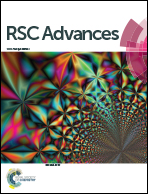Dual role of coal fly ash in copper ion adsorption followed by thermal stabilization in a spinel solid solution†
Abstract
Coal fly ash is usually used as a cost-effective adsorbent for heavy metal removal, accumulating large amounts of spent coal fly ash that requires further disposal. In this study, fly ash that adsorbs copper with a maximum copper adsorption capacity of 48.8 mg g−1 was further sintered at 900–1050 °C, and it was found that the copper is thermally incorporated in a spinel structure in aluminum- and iron-containing ceramic matrices provided by the fly ash. To further explore the immobilization mechanisms of copper in both aluminum- and iron-containing ceramic matrices like those in fly ash, two systems were prepared from CuO + Fe2O3 + kaolinite and CuO + Fe2O3 + Al2O3. A CuAlxFe2−xO4 spinel solid solution was formed, the peak intensity of which was found to increase upon an increase in the sintering temperature until a maximum amount was reached at 1150 °C. In the CuO + Fe2O3 + Al2O3 system, the 2θ value of the CuAlxFe2−xO4 peaks was found to increase due to the continuous engagement of aluminum in the spinel structure. However, iron was found to be more likely to react with the copper in CuO + Fe2O3 + kaolinite during the formation of CuAlxFe2−xO4. Through effective adsorption of copper on coal fly ash and the subsequent copper stabilization in the spinel, this study found a dual role for fly ash in copper immobilization and further confirmed the potential to recycle waste coal fly ash as a marketable ceramic material.



 Please wait while we load your content...
Please wait while we load your content...